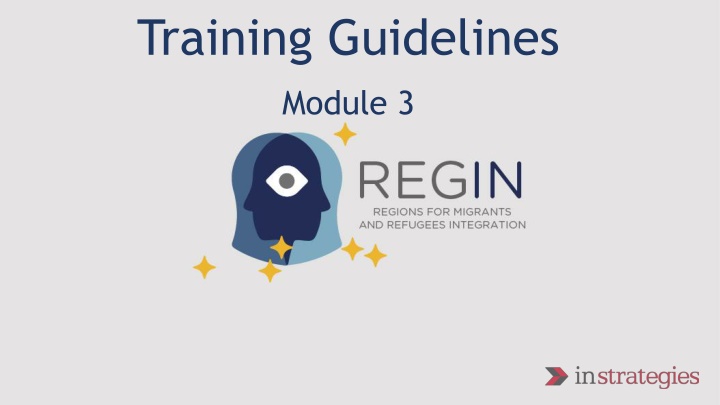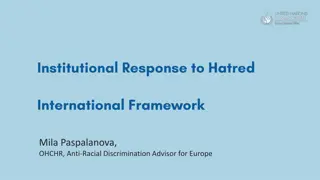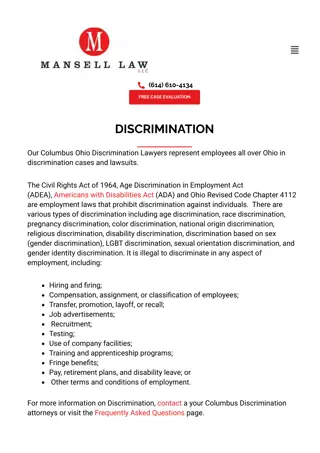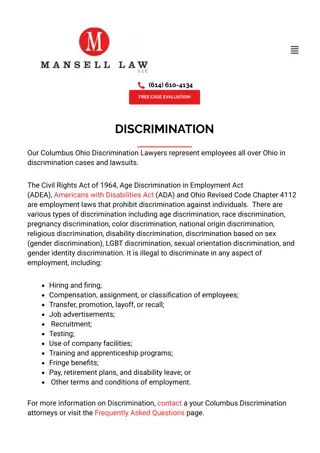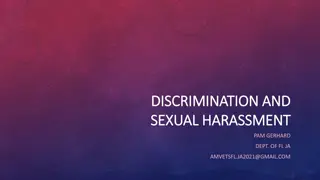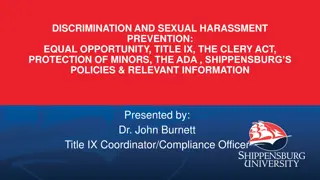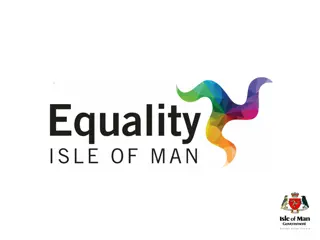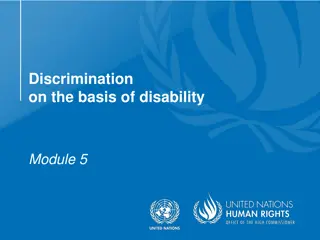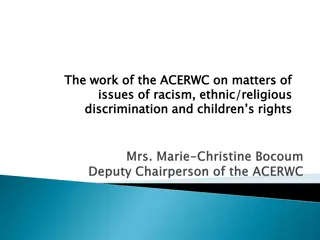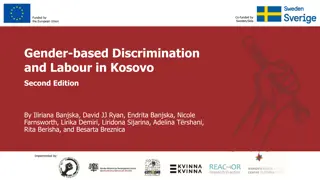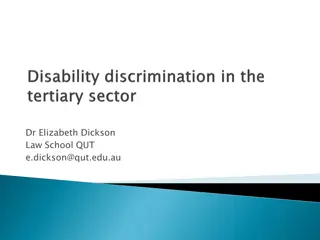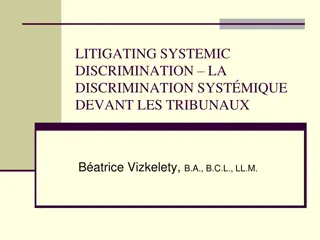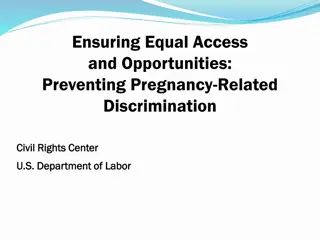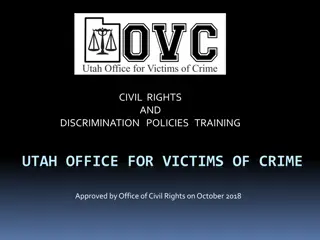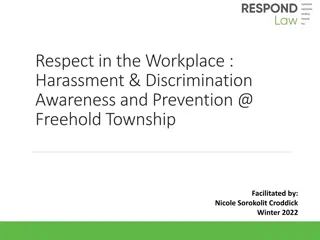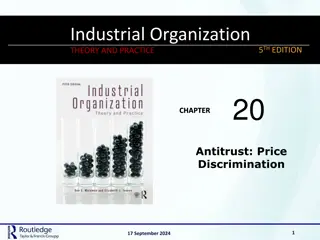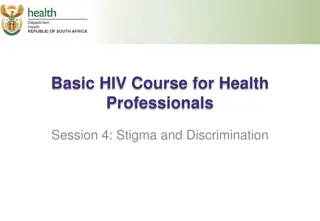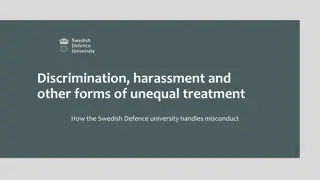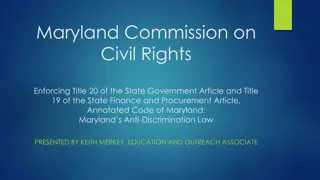Training Guidelines and Methodology for Fighting Discrimination
The training module focuses on combating racism, xenophobia, and discrimination through practical exercises and theoretical frameworks. It includes sessions on understanding discrimination, EU frameworks, good practices, and ways to fight against various forms of discrimination. The methodology incorporates practical exercises, group discussions, and a roadmap for inclusion. Participants will gain insights into addressing racism, enhancing victim's self-esteem, preventing discrimination, and fighting structural discrimination in education and employment.
Download Presentation

Please find below an Image/Link to download the presentation.
The content on the website is provided AS IS for your information and personal use only. It may not be sold, licensed, or shared on other websites without obtaining consent from the author.If you encounter any issues during the download, it is possible that the publisher has removed the file from their server.
You are allowed to download the files provided on this website for personal or commercial use, subject to the condition that they are used lawfully. All files are the property of their respective owners.
The content on the website is provided AS IS for your information and personal use only. It may not be sold, licensed, or shared on other websites without obtaining consent from the author.
E N D
Presentation Transcript
Training Guidelines Module 3
STRUCTURE OF THE SESSION Each session will be divided in 4 main parts: 1. Opening part to build-up the group: Watch the video https://www.youtube.com/watch?v=QRZPw-9sJtQ (2.44 ) 2. Explanation of Theorical Framework (15 ). 3. Practical Exercise (individual and group sharing):20 Roadmap to fight against racism, xenophobia and discrimination (17 ).
METHODOLOGY The methodology will be eminently practical. All modules will include a practical exercise and a roadmap to inclusion. In the complementary material you can find the theoretical notions for the knowledge of the concepts. The trainer(s)/ facilitator(s) will give a short introduction (5 ) on the key questions and an explanation of the theorical framework. Then, they have to do an individual exercise and share it in the group. This will lead to a road map to fight against racism, xenophobia and discrimination: New ideas on how to fight against racism, xenophobia and discrimination. Psychological factor: address possible ways on how to enhance victim s self-esteem. Awareness, how to prevent racism, xenophobia and discrimination. Education/ Job: fight against structural discrimination. The trainer/ facilitator, together with a person designated by the group, should take note of the main reflections to be able to present them at the round table at the end of the modules.
CONTENTS About Discrimination EU framework to fight discrimination Confronting discrimination Good practices in Europe
1. About Discrimination Discrimination: treating people differently, negatively and adversely on grounds of their racial or ethnic origin, religion or beliefs, disability, age and sexual orientation. Racism: The marginalization and/or oppression of people of color based on a socially constructed racial hierarchy that privileges white people.
1. About Discrimination (3) Main types of discrimination racial or ethnic origin, religion or beliefs, disability (physical disability, learning difficulties or mental illness) age and sexual orientation.
1. About Discrimination (4) At work, including: - opportunities for promotion, and - in seeking work In education, asked separately for experiences in: - primary school - secondary school and university or high school In seeking housing. In accessing various services, such as in restaurants, shops or from insurance companies.
2. EU Framework to Fight Discrimination Directive 2000/43/EC against discrimination on grounds of race and ethnic origin. Directive 2000/78/EC against discrimination at work on grounds of religion or belief, disability, age or sexual orientation. Directive 2006/54/EC equal treatment for men and women in matters of employment and occupation. Directive 2004/113/EC equal treatment for men and women in the access to and supply of goods and services. Directive Proposal (COM(2008)462) against discrimination based on age, disability, sexual orientation and religion or belief beyond the workplace.
2. EU Framework to Fight Discrimination (&4) https://www.echr.coe.int/Documents/Handbook_non_discri_l aw_ENG.pdf
3. Confronting Discrimination Intercultural communication Intercultural communication studies often focus on how cultural groups differ from one another. Intercultural communication has been defined in many ways- from a pattern of perceptions that influence communication to a site of contestation and conflict.
4. Good Practices in the EU https://ec.europa.eu/migrant-integration/home
PRACTICAL EXERCISE It will work in groups of 3-4 people. Each group will carry out a practical role-play exercise of a case of a racist, xenophobic, discriminatory incident / real hate crime. The aim of covering the care of the victim in the early stages (instructions will be provided). 3 cards with real examples will be delivered. The roles of the group will be divided: a victim, a companion, a policeman, a professional from an external service (translator, NGO technician, health worker, social worker ...) who will not act, he will only observe, a neutral observer who must narrate the case at the end in plenary. The dynamics of the roles of each sub-group are explained. The moderator will rotate through the three groups taking notes without intervening. Estimated duration: 20 minutes.
Thank you! https://regin-guidelines-training.eu/ In collaboration with CIDALIA
